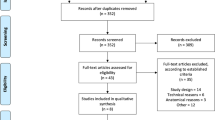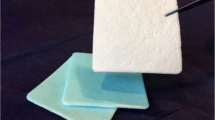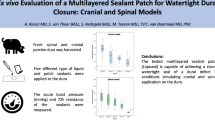Abstract
The objective of this study is to evaluate the efficacy and safety of non-suture dural closure using a novel dural substitute (GM111) consisting of polyglycolic acid felt with a fibrin-glue-coated area commensurate in size with the dural defect. This was a non-controlled, open-label, multicenter clinical trial. The efficacy evaluation endpoints were (1) GM111’s intra-operative capability to close dural defects and (2) prevention of cerebrospinal fluid (CSF) leakage and subcutaneous CSF retention throughout the postoperative period (evaluated by diagnostic imaging). Patients meeting the following three preoperative and two intra-operative selection criteria were enrolled: (1) between 12 and <75 years of age; (2) the dura is surmised to be defective and in need of reconstruction; (3) informed written consent was obtained from the patient; (4) the surgical wound is class 1; and (5) the size of duraplasty is ≥0.2 cm2 to <100 cm2. Sixty patients were enrolled. The craniotomy site was supratentorial in 77.2%, infratentorial in 12.3% and sellar in 10.5%. The GM111 prosthesis size ranged from 0.24 to 42 cm2. To evaluate the efficacy, intra-operative closure was confirmed by Valsalva’s maneuver, water infusion, etc., in all patients. CSF leakage and subcutaneous CSF retention throughout the postoperative period were found in four patients. Adverse events for which a causal relationship with GM111 could not be ruled out occurred in 8.8% of the patients. There were no instances of postoperative infection due to GM111. GM111 showed good closure capability and safety when used for non-suture dural closure.
Graphical Abstract




Similar content being viewed by others
References
Timms C, Trost N, Wang YY, Murphy M. Brainstem distortion from postoperative cerebellar herniation through a dural and bony defect. J Clin Neurosci. 2008;15:1050–1.
Hutter G, Felten Sv, Sailer MH, Schulz M, Mariani L. Risk factors for postoperative CSF leakage after elective craniotomy and the efficacy of fleece-bound tissue sealing against dural suturing alone: a randomised controlled trial. J Neurosurg. 2014;121:735–44.
Terasaka S, Iwasaki Y, Kuroda S, Uchida T. A novel method of dural repair using polyglycolic acid non-woven fabric and fibrin glue: clinical results of 140 cases. No Shinkei Geka. 2006;34(11):1109–17.
Yamagata S, Goto K, Oda Y, Kikichi H. Clinical experience with expanded polytetrafluoroethylene sheet used as an artificial dura mater. Neurol Med Chir (Tokyo). 1993;33:582–85.
Kobayashi H, Asaoka K, Terasaka S, Murata J-i. Primary closure of cerebrospinal fluid fistula by nonpenetrating titanium clips in endoscopic endonasal transsphenoidal surgery: technical note. Skull Base. 2011;21:47–52.
Terasaka S, Iwasaki Y, Shinya N, Uchida T. Fibrin glue and polyglycolic acid nonwoven fabric as a biocompatible dural substitute. Neurosurgery. 2006;58(ONS Suppl 1):ONS134–9.
Chaplin JM, Constantino PD, Wolpoe ME, Bederson JB, Griffey ES, Zhang W. Use of an acellular dermal allograft for dural replacement: an experimental study. Neurosurgery. 1999;45(2):320–7.
Warren WL, Medary MB, Dureza CD, et al. Dural repair using acellular human dermis: experience with 200 cases: technical assessment. Neurosurgery. 2000;46(6):1391–96.
Yamada K, Miyamoto S, Takayama M, et al. Clinical application of a new bioabsorbable artificial dura mater. J Neurosurg. 2002;96:731–5.
Chauvet D, Tran V, Mutlu G, George B, Allain J-M. Study of dural suture watertightness: an vitro comparison of different sealants. Acta Neurochir. 2011;153:2465–72.
Danish SF, Samdani A, Hanna A, Storm P, Sutton L. Experience with acellular human dura and bovine collagen matrix for duraplasty after posterior fossa decompression for chiari malformation. J Neurosurg. 2006;104(Suppl Pediatrics):16–20.
Krieger MD, McComb JG, Levy ML. Toward a simpler surgical management of chiari malformation in a pediatric population. Pediatr Neurosurg. 1999;30:113–21.
Parizek J, Mericka P, Nemecek S, et al. Posterior cranial fossa surgery in 454 children. Comparison of results obtained in pre-CT and CT era and after various types of management of dura mater. Childs Nerv Syst. 1998;14(9):426–38.
Steinbok P, Singhal A, Mills J, Cochrane DD, Price AV. Cerebrospinal fluid (CSF) leak and pseudomeningocele formation after posterior fossa tumor resection in children: a retrospective analysis. Childs Nerv Syst. 2007;23:171–4.
Walcott BP, Neal JB, Sheth SA, et al. The incidence of complications in elective cranial neurosurgery associated with dural closure material. J Neurosurg. 2014;120:278–84.
Moskowitz SI, Liu J, Krishnaney AA. Postoperative complications associated with dural substitute in suboccipital craniotomies. Neurosurgery. 2009;64(ONS Suppl 1):ons28–34.
Author information
Authors and Affiliations
Corresponding author
Ethics declarations
Conflict of interest
The authors declare that they have no competing interests.
Rights and permissions
About this article
Cite this article
Terasaka, S., Taoka, T., Kuroda, S. et al. Efficacy and safety of non-suture dural closure using a novel dural substitute consisting of polyglycolic acid felt and fibrin glue to prevent cerebrospinal fluid leakage—A non-controlled, open-label, multicenter clinical trial—. J Mater Sci: Mater Med 28, 69 (2017). https://doi.org/10.1007/s10856-017-5877-8
Received:
Accepted:
Published:
DOI: https://doi.org/10.1007/s10856-017-5877-8




